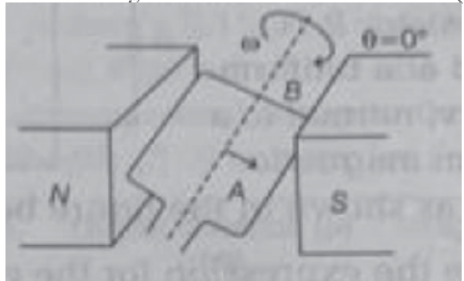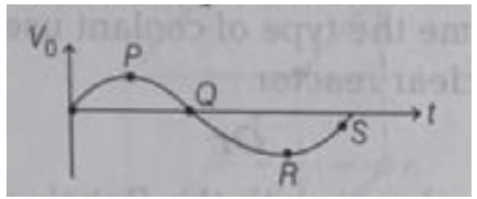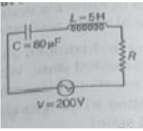Please refer to Alternating Current Class 12 Physics Important Questions with solutions provided below. These questions and answers have been provided for Class 12 Physics based on the latest syllabus and examination guidelines issued by CBSE, NCERT, and KVS. Students should learn these problem solutions as it will help them to gain more marks in examinations. We have provided Important Questions for Class 12 Physics for all chapters in your book. These Board exam questions have been designed by expert teachers of Standard 12.
Class 12 Physics Important Questions Alternating Current
Case Based Questions :
Transformer is a device which is used to increase or decrease the alternating voltage. A transformer can be a step-up transformer or a step-down transformer. Transformer is based upon the principle of mutual induction.
It consists of two coils, primary coil (p) and secondary coil (s), insulated from each other and wound on a soft iron core. Often the primary coil is the input coil and the secondary coil is the output coil. These soft iron cores are laminated to minimise eddy current loss.

Question. A transformer has 150 turns in its primary and 1000 turns in its secondary coil. If the primary coil is connected to a 440 V DC supply, what will be the induced voltage in the secondary
(a) zero
(b) 3 V
(c) 5 V
(d) 10 V
Answer
A
Question. The ratio of secondary to primary turns in an ideal transformer is 4 : 5. If power input is P, then the ratio of power output to power input is
(a) 4 : 9
(b) 9 : 4
(c) 5 : 4
(d) 1 : 1
Answer
D
Question. A power transmission line feeds input power at 2300 V to a step-down transformer with its primary coil having 4000 turns. What should be the number of turns in the secondary in order to get output power at 230V?
(a) 600
(b) 550
(c) 400
(d) 375
Answer
C
Question. What is not possible in a transformer?
(a) Eddy current
(b) Direct current
(c) Alternating current
(d) Induced current
Answer
B
Question. Which quantities do not change during transformer operation?
(a) Power
(b) Frequency
(c) Voltage
(d) Both (a) and (b)
Answer
D
An AC generator produces electrical energy from mechanical work, just the opposite of what a motor does.
In it, a shaft is rotated by some mechanical means, such as when an engine or a turbine starts working and an emf is induced in the coil. It is based on the phenomenon of electromagnetic induction which states that whenever magnetic flux linked with a conductor (or coil) changes, an emf is induced in the coil.

Question. The change of flux is maximum at θ (given Φ = NBAcos θ)
(a) 90°, 270°
(b) 90°, 45°
(c) 60°, 90°
(d) 180°, 90°
Answer
A
Question. The graph below shows the voltage output plotted against time. Which point on the graph shows that the coil is in a vertical position?

(a) P
(b) Q
(c) R
(d) S
Answer
B
Question. An AC generator consists of a coil of 1000 turns and a cross-sectional area of 100 cm2, rotating at an angular speed of 100 rpm in a uniform magnetic field of 3.6 X 10-2 T. The maximum emf produced in the coil is
(a) 1.77 V
(b) 2.77 V
(c) 3.77 V
(d) 4.77 V
Answer
C
Question. Which method is used to induce an emf or current in a loop in AC generator?
(a) A change in the loop’s orientation
(b) A change in its effective area
(c) Both (a) and (b)
(d) Neither (a) nor (b)
Answer
C
Question. When the coil is rotated with a constant angular speed ω, the angle θ between the magnetic field vector B and the area vector A of the coil at any instant t, is
(a) θ = AB
(b) θ = At
(c) θ = ωt
(d) θ = Bt
Answer
C
Electrical resonance is said to take place in a series L-C-R circuit when the circuit allows maximum current for a given frequency of the source of alternating supply for which capacitive reactance becomes equal to the inductive reactance. Impedance of this L-C-R circuit is minimum and hence current is maximum. Resonant circuits are used to respond selectively to signals of a given frequency while discriminating against signals of different frequencies. If the response of the circuit is more narrowly peaked around the chosen frequency, we say that the circuit has higher “selectivity of sharpness”. This sharpness is measured as Q-factor.
Question. In a non-resonant circuit, what will be the nature of a circuit for frequencies higher than the resonant frequency?
(a) Resistive
(b) Capacitive
(c) Inductive
(d) None of the above
Answer
C
Question. The figure shows a series L-C-R circuit connected to a variable frequency 200 V source. C = 80 μF and R = 40 Ω. The source frequency which drives the circuit at resonance is

(a) 25 Hz
(b) 25/π Hz
(c) 50 Hz
(d) 50/π Hz
Answer
B
Question. Bandwidth of the resonant L-C-R circuit is
(a) R/ L
(b) R/ 2L
(c) 2R/ L
(d) 4R/ L
Answer
B
Question. To reduce the resonant frequency in an L-C-R series circuit with a generator
(a) the generator frequency should be reduced
(b) another capacitor should be added in parallel to the first
(c) the iron core of the inductor should be removed
(d) dielectric in the capacitor should be removed
Answer
B
Question. In a series L-C-R circuit, the capacitance C is changed to 4C. To keep the resonant frequency the same, the inductance must be changed by
(a) 2 L
(b) L/ 2
(c) 4 L
(d) L/ 4
Answer
D

